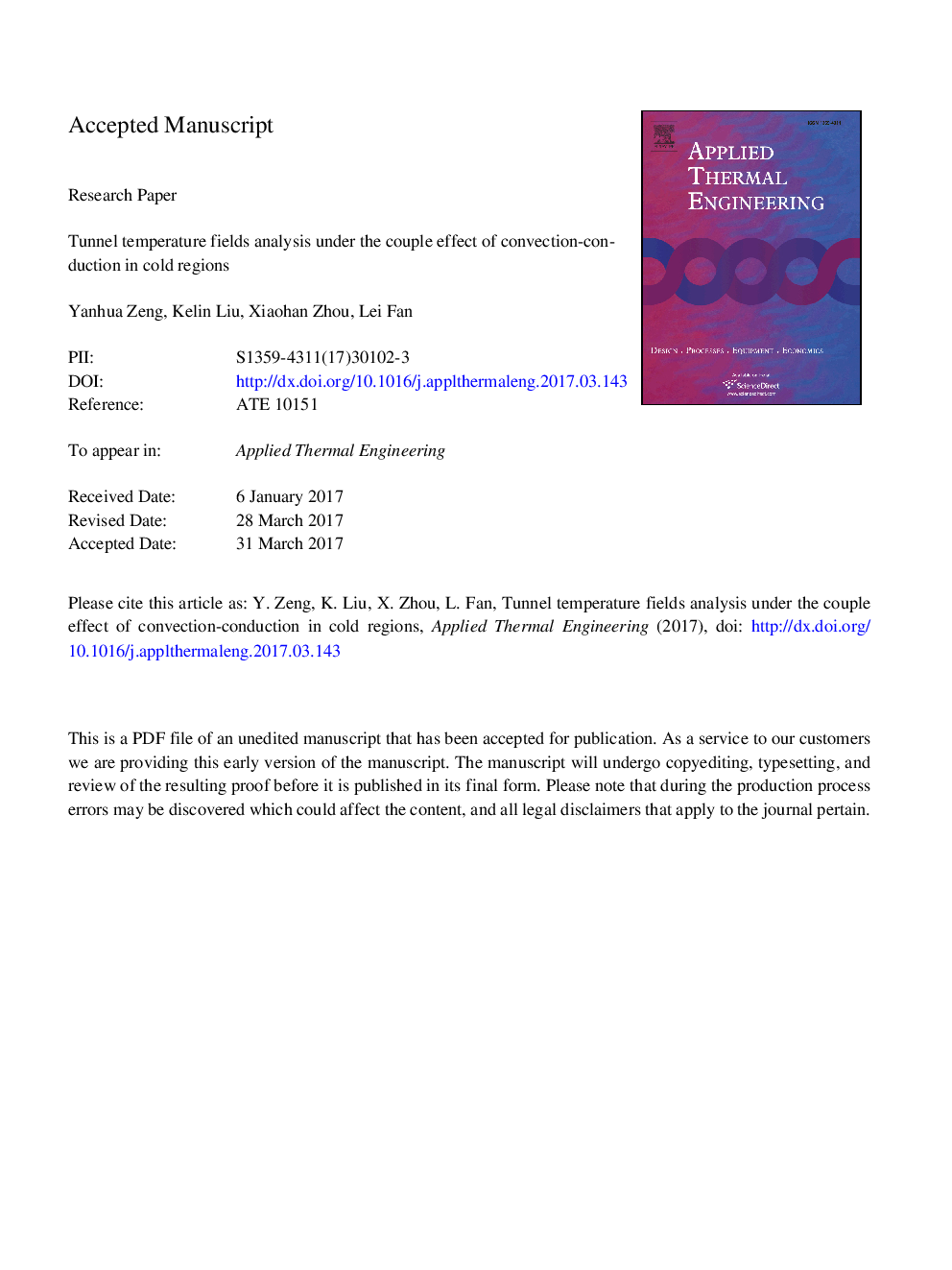| کد مقاله | کد نشریه | سال انتشار | مقاله انگلیسی | نسخه تمام متن |
|---|---|---|---|---|
| 4991016 | 1457109 | 2017 | 25 صفحه PDF | دانلود رایگان |
عنوان انگلیسی مقاله ISI
Tunnel temperature fields analysis under the couple effect of convection-conduction in cold regions
ترجمه فارسی عنوان
تجزیه و تحلیل میدان های تونل تحت اثر زوج هدایت حرارتی در مناطق سرد
دانلود مقاله + سفارش ترجمه
دانلود مقاله ISI انگلیسی
رایگان برای ایرانیان
کلمات کلیدی
تونل در منطقه سرد، جابجایی-هدایت، زمینه دما، تست مدل،
ترجمه چکیده
این مقاله یک تست مدل شبیه سازی شباهت با مقیاس هندسی 1:30 با استفاده از بخش تونل راه آهن هارمونیک عمل می کند تا اثر زوج هدایت حرارتی با جریان هوا کم جریان ورودی را بررسی کند. دمای ورودی کم با سیستم خنک کننده تولید می شود. نتایج نشان می دهد که دمای جریان هوا و سنگ اطراف آن به سرعت در ابتدای آزمایش کاهش می یابد و پس از آن کاهش می یابد؛ نزدیک تر به ورودی تونل تغییرات شدید هوا در جریان هوا و سنگ اطراف آن خواهد بود؛ دمای جریان هوا و سنگ اطراف آن با تغییرات دمای ورودی تغییر می کند، اما نوسانات هیسترتیک است. سپس نتایج آزمایش شده با نتایج متفاوتی محاسبه شده و زمینه های دما تحت شرایط مختلف ورودی، سرعت تهویه و تهویه مکانیکی مورد تجزیه و تحلیل قرار گرفته است. از نتایج می توان نتیجه گرفت که نتایج آزمایش شده با نتایج محاسبه شده با نتایج محدود همخوانی دارند؛ سرعت بالاتر تهویه و پایین تر درجه حرارت ورودی، سریع تر کاهش دما خواهد بود؛ در جهت تهویه مثبت، سرعت تهویه مکانیکی بالا (بالاتر از سرعت طبیعی) اثر منفی بر آسیب انجماد در تونل دارد؛ جهت تهویه منفی، تا حدودی، برای کاهش آسیب های انجماد مفید است.
موضوعات مرتبط
مهندسی و علوم پایه
مهندسی شیمی
جریان سیال و فرایندهای انتقال
چکیده انگلیسی
This paper performs a similarity simulation model test with 1:30 geometric scale based on practical horseshoe railway tunnel section to investigate the couple effect of convection-conduction with low inlet temperature airflow. The low inlet temperature is produced by refrigerating system. The results show that the temperature of airflow and surrounding rock drop rapidly at the beginning of the test and then slow down with time; the closer to the entrance of the tunnel, the strongly temperature changes of airflow and surrounding rock will be; temperature of airflow and surrounding rock fluctuate with the changes of inlet temperature, but the fluctuation is hysteretic. Then, the tested results are compared with finite difference calculated results and temperature fields are analyzed under different inlet temperature, ventilation velocities and mechanical ventilation. It can be seen from the results that, tested results agree well with finite difference calculated results; the higher the ventilation velocity and the lower the inlet temperature are, the more rapidly the temperature reduction will be; in the positive ventilation direction, high mechanical ventilation velocity (higher than natural velocity) has adverse effect on freezing damage in tunnel; negative ventilation direction, to some extent, does good to alleviate freezing damage.
ناشر
Database: Elsevier - ScienceDirect (ساینس دایرکت)
Journal: Applied Thermal Engineering - Volume 120, 25 June 2017, Pages 378-392
Journal: Applied Thermal Engineering - Volume 120, 25 June 2017, Pages 378-392
نویسندگان
Yanhua Zeng, Kelin Liu, Xiaohan Zhou, Lei Fan,
